HI5019 Strategic Information Systems: Foodland Australia Analysis
VerifiedAdded on 2023/06/07
|17
|3905
|479
Report
AI Summary
This report provides an external and internal business analysis of Foodland Australia, a supermarket brand with 120 locations. The report includes a business background, general environment analysis covering economic, physical, socio-cultural, technological, political/legal, and demographic aspects. It also examines the industry environment using Porter's Five Forces, analyzes the competitive environment, and identifies opportunities and threats. The internal analysis focuses on tangible and intangible resources, capabilities, and core competencies. The report concludes by suggesting a suitable information system and decision support system for Foodland Australia.
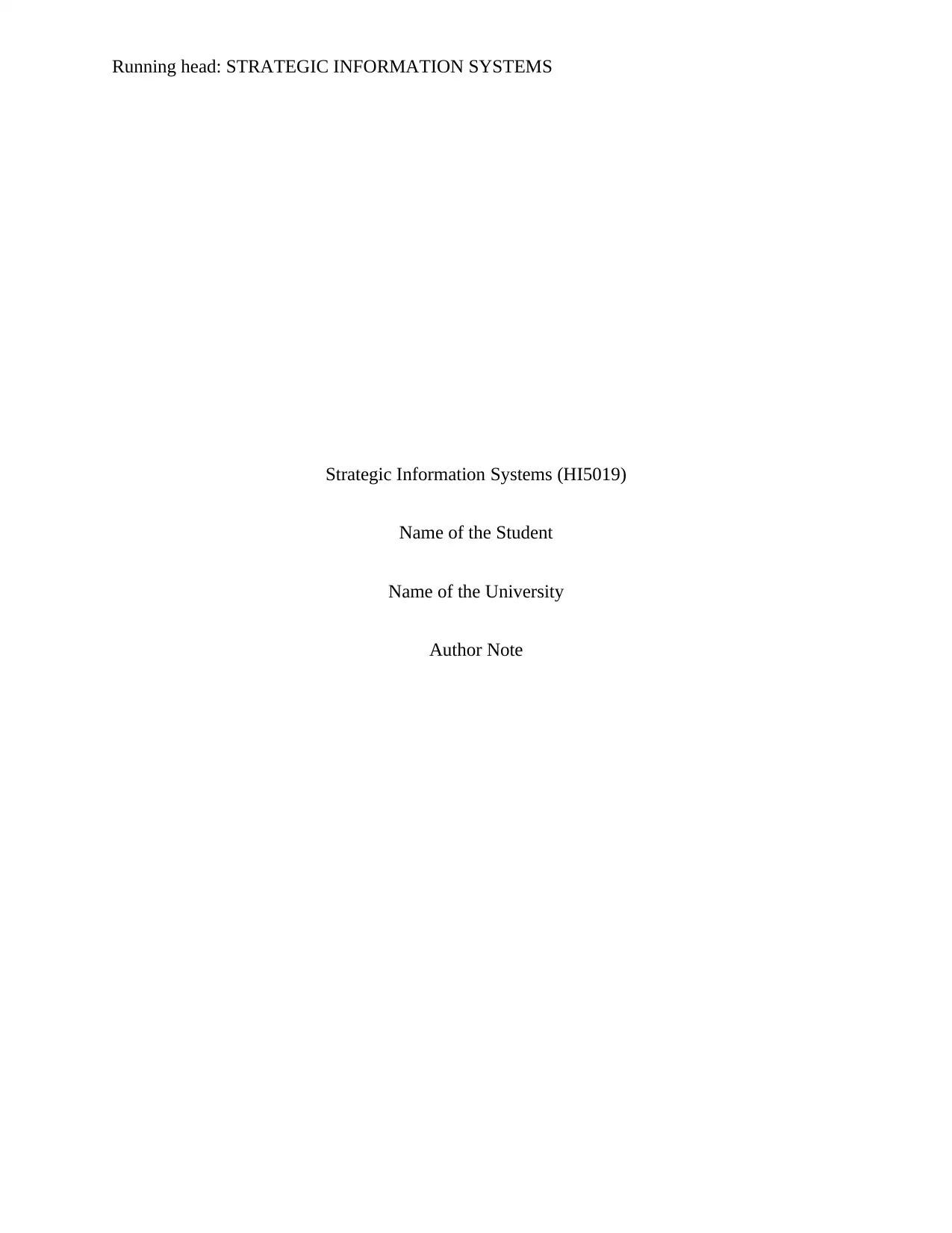
Running head: STRATEGIC INFORMATION SYSTEMS
Strategic Information Systems (HI5019)
Name of the Student
Name of the University
Author Note
Strategic Information Systems (HI5019)
Name of the Student
Name of the University
Author Note
Paraphrase This Document
Need a fresh take? Get an instant paraphrase of this document with our AI Paraphraser
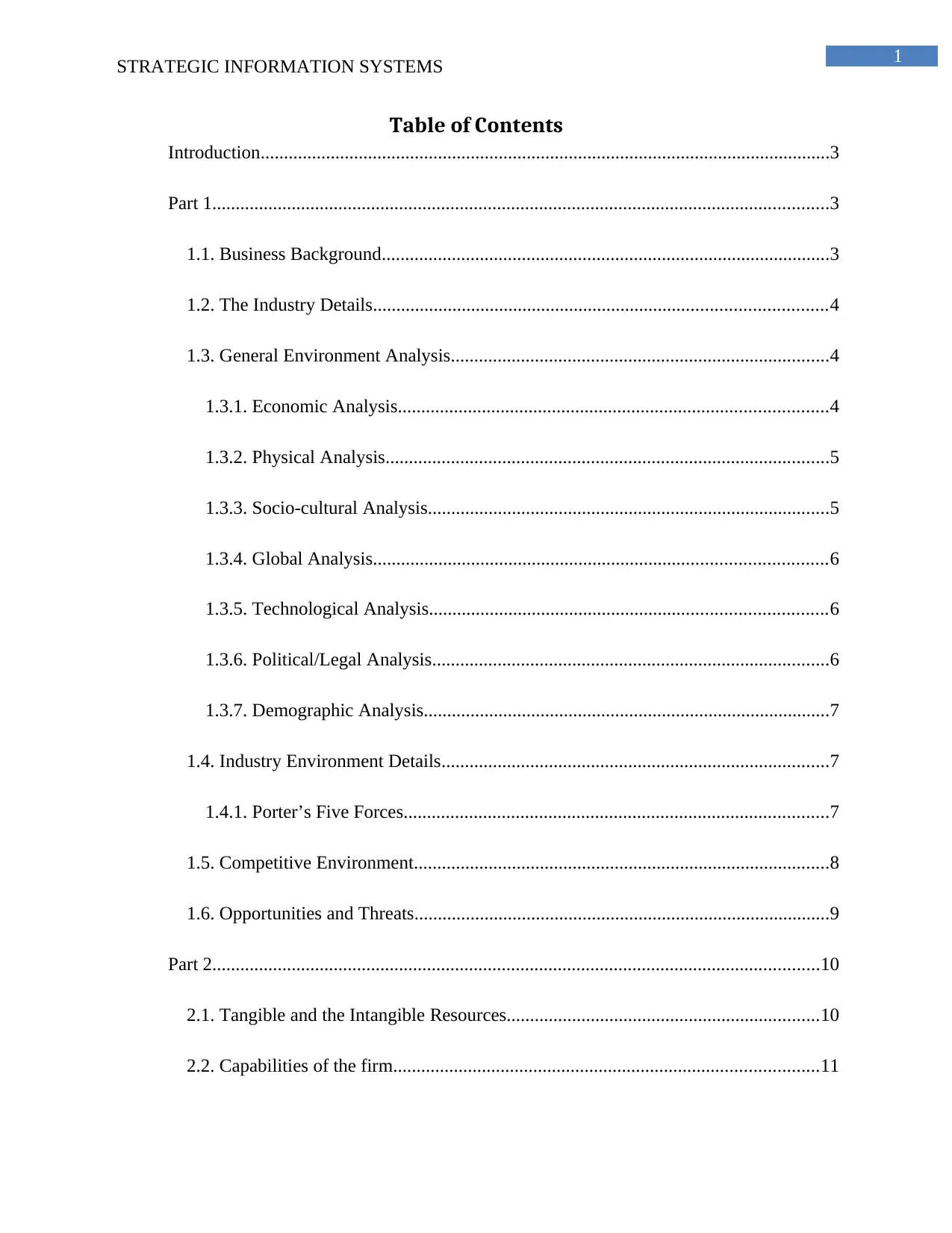
1
STRATEGIC INFORMATION SYSTEMS
Table of Contents
Introduction..........................................................................................................................3
Part 1....................................................................................................................................3
1.1. Business Background................................................................................................3
1.2. The Industry Details.................................................................................................4
1.3. General Environment Analysis.................................................................................4
1.3.1. Economic Analysis............................................................................................4
1.3.2. Physical Analysis...............................................................................................5
1.3.3. Socio-cultural Analysis......................................................................................5
1.3.4. Global Analysis.................................................................................................6
1.3.5. Technological Analysis.....................................................................................6
1.3.6. Political/Legal Analysis.....................................................................................6
1.3.7. Demographic Analysis.......................................................................................7
1.4. Industry Environment Details...................................................................................7
1.4.1. Porter’s Five Forces...........................................................................................7
1.5. Competitive Environment.........................................................................................8
1.6. Opportunities and Threats.........................................................................................9
Part 2..................................................................................................................................10
2.1. Tangible and the Intangible Resources...................................................................10
2.2. Capabilities of the firm...........................................................................................11
STRATEGIC INFORMATION SYSTEMS
Table of Contents
Introduction..........................................................................................................................3
Part 1....................................................................................................................................3
1.1. Business Background................................................................................................3
1.2. The Industry Details.................................................................................................4
1.3. General Environment Analysis.................................................................................4
1.3.1. Economic Analysis............................................................................................4
1.3.2. Physical Analysis...............................................................................................5
1.3.3. Socio-cultural Analysis......................................................................................5
1.3.4. Global Analysis.................................................................................................6
1.3.5. Technological Analysis.....................................................................................6
1.3.6. Political/Legal Analysis.....................................................................................6
1.3.7. Demographic Analysis.......................................................................................7
1.4. Industry Environment Details...................................................................................7
1.4.1. Porter’s Five Forces...........................................................................................7
1.5. Competitive Environment.........................................................................................8
1.6. Opportunities and Threats.........................................................................................9
Part 2..................................................................................................................................10
2.1. Tangible and the Intangible Resources...................................................................10
2.2. Capabilities of the firm...........................................................................................11
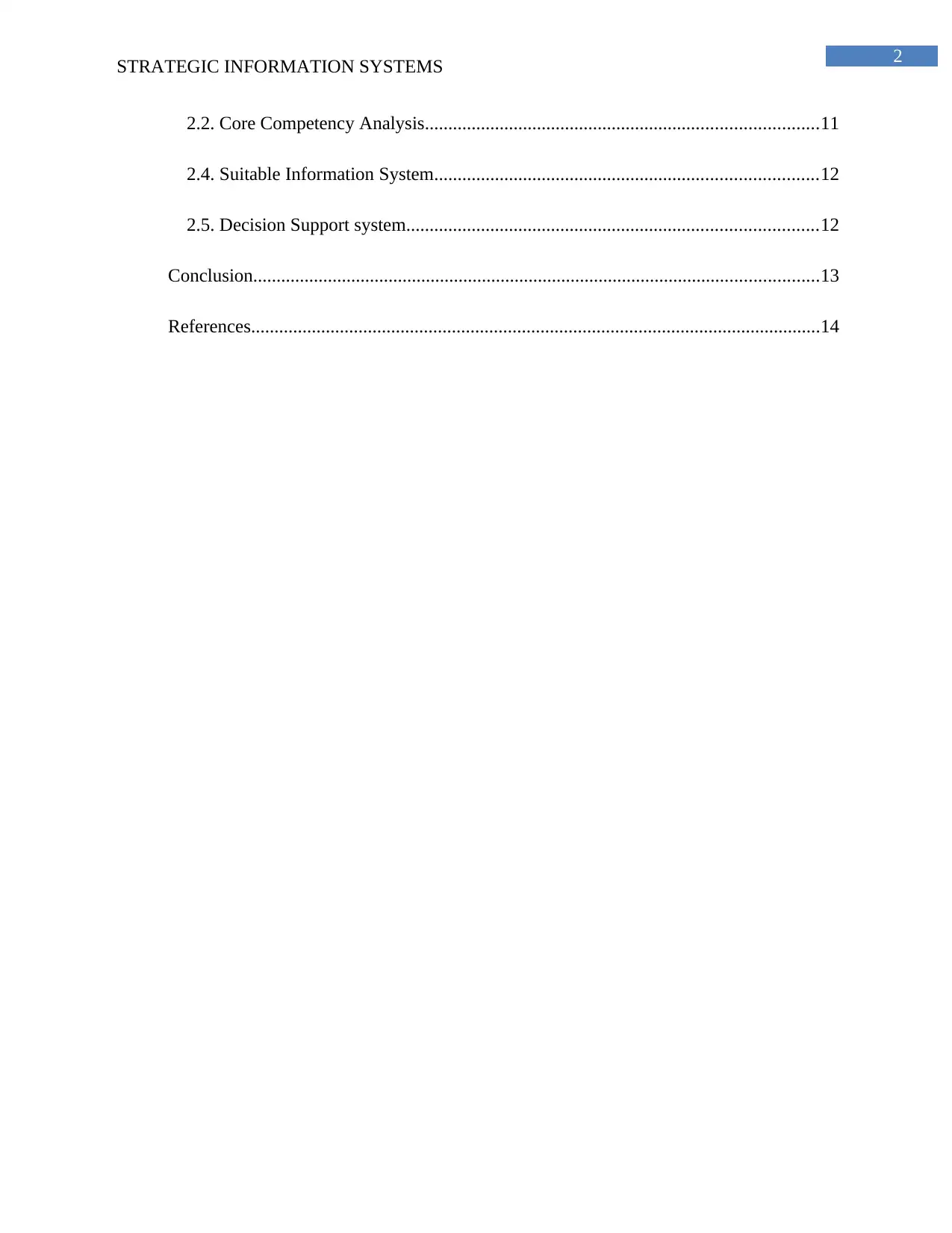
2
STRATEGIC INFORMATION SYSTEMS
2.2. Core Competency Analysis....................................................................................11
2.4. Suitable Information System..................................................................................12
2.5. Decision Support system........................................................................................12
Conclusion.........................................................................................................................13
References..........................................................................................................................14
STRATEGIC INFORMATION SYSTEMS
2.2. Core Competency Analysis....................................................................................11
2.4. Suitable Information System..................................................................................12
2.5. Decision Support system........................................................................................12
Conclusion.........................................................................................................................13
References..........................................................................................................................14
⊘ This is a preview!⊘
Do you want full access?
Subscribe today to unlock all pages.

Trusted by 1+ million students worldwide
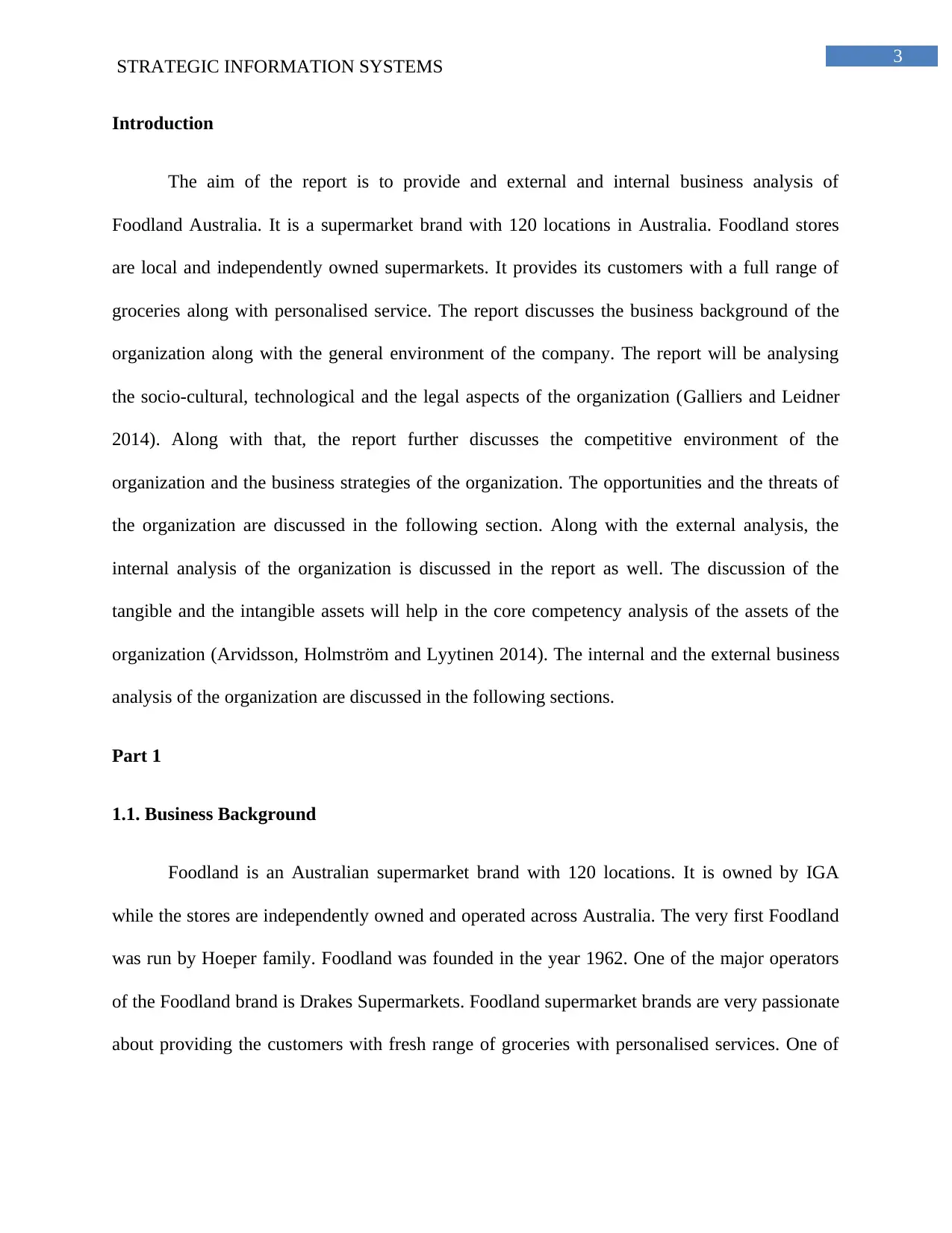
3
STRATEGIC INFORMATION SYSTEMS
Introduction
The aim of the report is to provide and external and internal business analysis of
Foodland Australia. It is a supermarket brand with 120 locations in Australia. Foodland stores
are local and independently owned supermarkets. It provides its customers with a full range of
groceries along with personalised service. The report discusses the business background of the
organization along with the general environment of the company. The report will be analysing
the socio-cultural, technological and the legal aspects of the organization (Galliers and Leidner
2014). Along with that, the report further discusses the competitive environment of the
organization and the business strategies of the organization. The opportunities and the threats of
the organization are discussed in the following section. Along with the external analysis, the
internal analysis of the organization is discussed in the report as well. The discussion of the
tangible and the intangible assets will help in the core competency analysis of the assets of the
organization (Arvidsson, Holmström and Lyytinen 2014). The internal and the external business
analysis of the organization are discussed in the following sections.
Part 1
1.1. Business Background
Foodland is an Australian supermarket brand with 120 locations. It is owned by IGA
while the stores are independently owned and operated across Australia. The very first Foodland
was run by Hoeper family. Foodland was founded in the year 1962. One of the major operators
of the Foodland brand is Drakes Supermarkets. Foodland supermarket brands are very passionate
about providing the customers with fresh range of groceries with personalised services. One of
STRATEGIC INFORMATION SYSTEMS
Introduction
The aim of the report is to provide and external and internal business analysis of
Foodland Australia. It is a supermarket brand with 120 locations in Australia. Foodland stores
are local and independently owned supermarkets. It provides its customers with a full range of
groceries along with personalised service. The report discusses the business background of the
organization along with the general environment of the company. The report will be analysing
the socio-cultural, technological and the legal aspects of the organization (Galliers and Leidner
2014). Along with that, the report further discusses the competitive environment of the
organization and the business strategies of the organization. The opportunities and the threats of
the organization are discussed in the following section. Along with the external analysis, the
internal analysis of the organization is discussed in the report as well. The discussion of the
tangible and the intangible assets will help in the core competency analysis of the assets of the
organization (Arvidsson, Holmström and Lyytinen 2014). The internal and the external business
analysis of the organization are discussed in the following sections.
Part 1
1.1. Business Background
Foodland is an Australian supermarket brand with 120 locations. It is owned by IGA
while the stores are independently owned and operated across Australia. The very first Foodland
was run by Hoeper family. Foodland was founded in the year 1962. One of the major operators
of the Foodland brand is Drakes Supermarkets. Foodland supermarket brands are very passionate
about providing the customers with fresh range of groceries with personalised services. One of
Paraphrase This Document
Need a fresh take? Get an instant paraphrase of this document with our AI Paraphraser
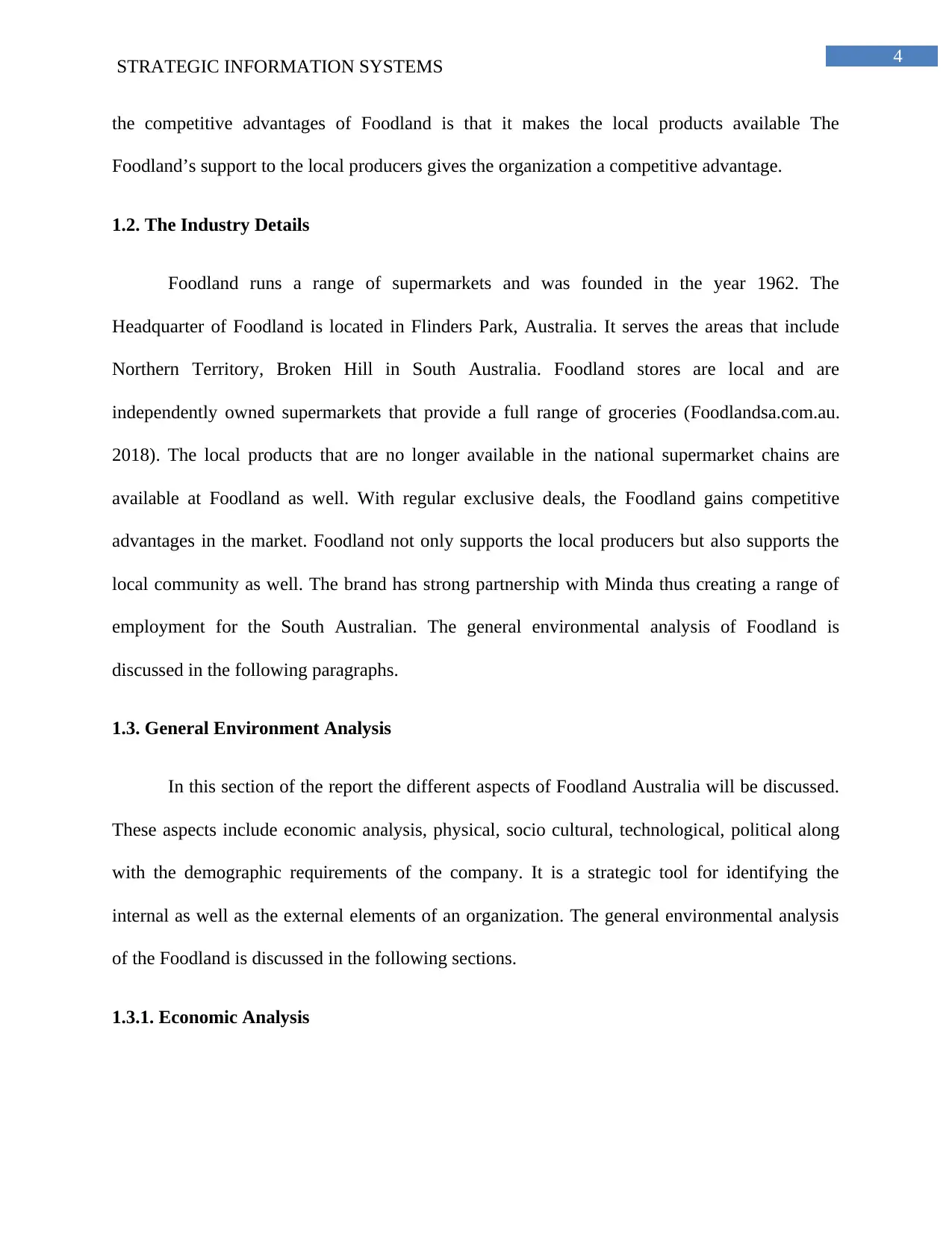
4
STRATEGIC INFORMATION SYSTEMS
the competitive advantages of Foodland is that it makes the local products available The
Foodland’s support to the local producers gives the organization a competitive advantage.
1.2. The Industry Details
Foodland runs a range of supermarkets and was founded in the year 1962. The
Headquarter of Foodland is located in Flinders Park, Australia. It serves the areas that include
Northern Territory, Broken Hill in South Australia. Foodland stores are local and are
independently owned supermarkets that provide a full range of groceries (Foodlandsa.com.au.
2018). The local products that are no longer available in the national supermarket chains are
available at Foodland as well. With regular exclusive deals, the Foodland gains competitive
advantages in the market. Foodland not only supports the local producers but also supports the
local community as well. The brand has strong partnership with Minda thus creating a range of
employment for the South Australian. The general environmental analysis of Foodland is
discussed in the following paragraphs.
1.3. General Environment Analysis
In this section of the report the different aspects of Foodland Australia will be discussed.
These aspects include economic analysis, physical, socio cultural, technological, political along
with the demographic requirements of the company. It is a strategic tool for identifying the
internal as well as the external elements of an organization. The general environmental analysis
of the Foodland is discussed in the following sections.
1.3.1. Economic Analysis
STRATEGIC INFORMATION SYSTEMS
the competitive advantages of Foodland is that it makes the local products available The
Foodland’s support to the local producers gives the organization a competitive advantage.
1.2. The Industry Details
Foodland runs a range of supermarkets and was founded in the year 1962. The
Headquarter of Foodland is located in Flinders Park, Australia. It serves the areas that include
Northern Territory, Broken Hill in South Australia. Foodland stores are local and are
independently owned supermarkets that provide a full range of groceries (Foodlandsa.com.au.
2018). The local products that are no longer available in the national supermarket chains are
available at Foodland as well. With regular exclusive deals, the Foodland gains competitive
advantages in the market. Foodland not only supports the local producers but also supports the
local community as well. The brand has strong partnership with Minda thus creating a range of
employment for the South Australian. The general environmental analysis of Foodland is
discussed in the following paragraphs.
1.3. General Environment Analysis
In this section of the report the different aspects of Foodland Australia will be discussed.
These aspects include economic analysis, physical, socio cultural, technological, political along
with the demographic requirements of the company. It is a strategic tool for identifying the
internal as well as the external elements of an organization. The general environmental analysis
of the Foodland is discussed in the following sections.
1.3.1. Economic Analysis
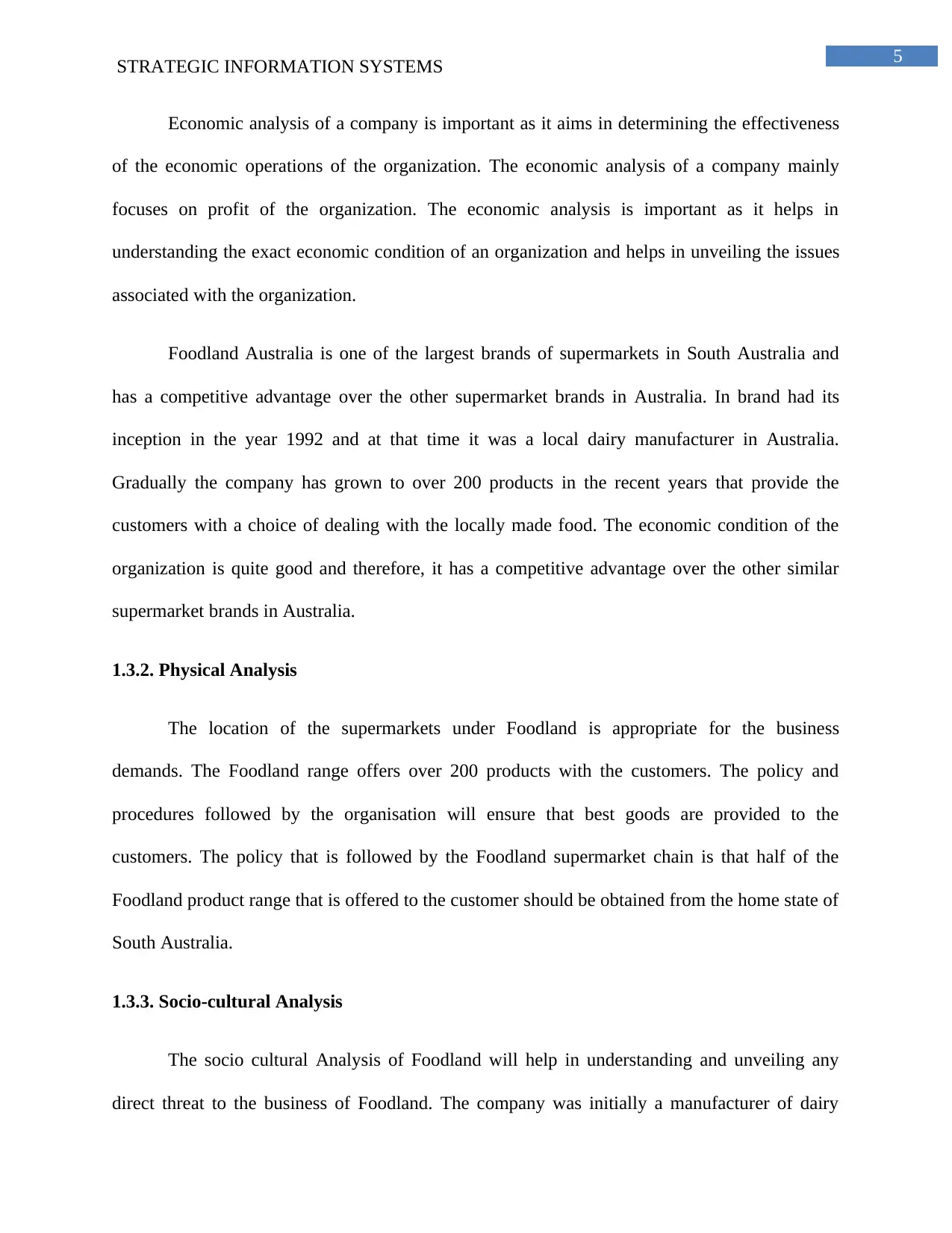
5
STRATEGIC INFORMATION SYSTEMS
Economic analysis of a company is important as it aims in determining the effectiveness
of the economic operations of the organization. The economic analysis of a company mainly
focuses on profit of the organization. The economic analysis is important as it helps in
understanding the exact economic condition of an organization and helps in unveiling the issues
associated with the organization.
Foodland Australia is one of the largest brands of supermarkets in South Australia and
has a competitive advantage over the other supermarket brands in Australia. In brand had its
inception in the year 1992 and at that time it was a local dairy manufacturer in Australia.
Gradually the company has grown to over 200 products in the recent years that provide the
customers with a choice of dealing with the locally made food. The economic condition of the
organization is quite good and therefore, it has a competitive advantage over the other similar
supermarket brands in Australia.
1.3.2. Physical Analysis
The location of the supermarkets under Foodland is appropriate for the business
demands. The Foodland range offers over 200 products with the customers. The policy and
procedures followed by the organisation will ensure that best goods are provided to the
customers. The policy that is followed by the Foodland supermarket chain is that half of the
Foodland product range that is offered to the customer should be obtained from the home state of
South Australia.
1.3.3. Socio-cultural Analysis
The socio cultural Analysis of Foodland will help in understanding and unveiling any
direct threat to the business of Foodland. The company was initially a manufacturer of dairy
STRATEGIC INFORMATION SYSTEMS
Economic analysis of a company is important as it aims in determining the effectiveness
of the economic operations of the organization. The economic analysis of a company mainly
focuses on profit of the organization. The economic analysis is important as it helps in
understanding the exact economic condition of an organization and helps in unveiling the issues
associated with the organization.
Foodland Australia is one of the largest brands of supermarkets in South Australia and
has a competitive advantage over the other supermarket brands in Australia. In brand had its
inception in the year 1992 and at that time it was a local dairy manufacturer in Australia.
Gradually the company has grown to over 200 products in the recent years that provide the
customers with a choice of dealing with the locally made food. The economic condition of the
organization is quite good and therefore, it has a competitive advantage over the other similar
supermarket brands in Australia.
1.3.2. Physical Analysis
The location of the supermarkets under Foodland is appropriate for the business
demands. The Foodland range offers over 200 products with the customers. The policy and
procedures followed by the organisation will ensure that best goods are provided to the
customers. The policy that is followed by the Foodland supermarket chain is that half of the
Foodland product range that is offered to the customer should be obtained from the home state of
South Australia.
1.3.3. Socio-cultural Analysis
The socio cultural Analysis of Foodland will help in understanding and unveiling any
direct threat to the business of Foodland. The company was initially a manufacturer of dairy
⊘ This is a preview!⊘
Do you want full access?
Subscribe today to unlock all pages.

Trusted by 1+ million students worldwide
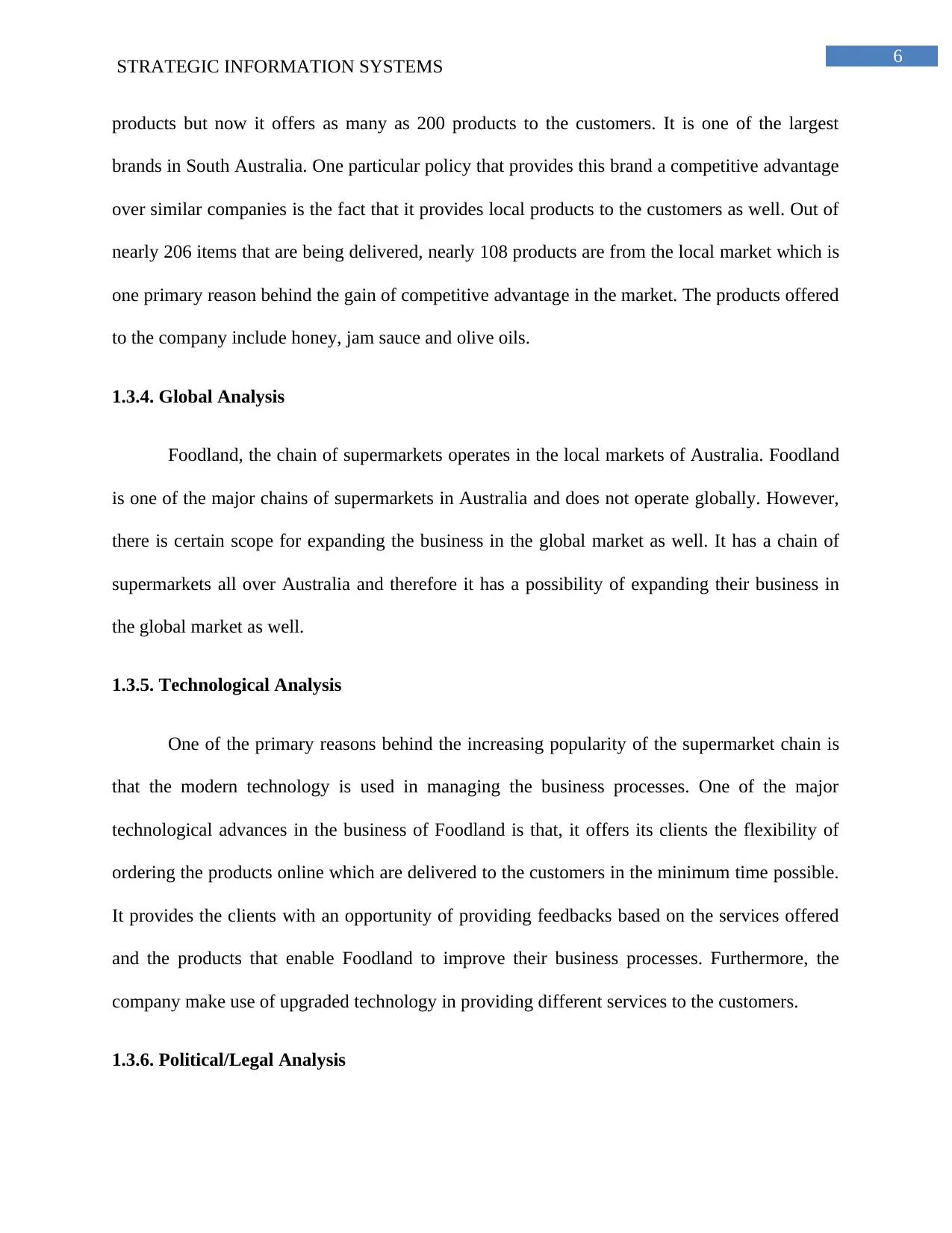
6
STRATEGIC INFORMATION SYSTEMS
products but now it offers as many as 200 products to the customers. It is one of the largest
brands in South Australia. One particular policy that provides this brand a competitive advantage
over similar companies is the fact that it provides local products to the customers as well. Out of
nearly 206 items that are being delivered, nearly 108 products are from the local market which is
one primary reason behind the gain of competitive advantage in the market. The products offered
to the company include honey, jam sauce and olive oils.
1.3.4. Global Analysis
Foodland, the chain of supermarkets operates in the local markets of Australia. Foodland
is one of the major chains of supermarkets in Australia and does not operate globally. However,
there is certain scope for expanding the business in the global market as well. It has a chain of
supermarkets all over Australia and therefore it has a possibility of expanding their business in
the global market as well.
1.3.5. Technological Analysis
One of the primary reasons behind the increasing popularity of the supermarket chain is
that the modern technology is used in managing the business processes. One of the major
technological advances in the business of Foodland is that, it offers its clients the flexibility of
ordering the products online which are delivered to the customers in the minimum time possible.
It provides the clients with an opportunity of providing feedbacks based on the services offered
and the products that enable Foodland to improve their business processes. Furthermore, the
company make use of upgraded technology in providing different services to the customers.
1.3.6. Political/Legal Analysis
STRATEGIC INFORMATION SYSTEMS
products but now it offers as many as 200 products to the customers. It is one of the largest
brands in South Australia. One particular policy that provides this brand a competitive advantage
over similar companies is the fact that it provides local products to the customers as well. Out of
nearly 206 items that are being delivered, nearly 108 products are from the local market which is
one primary reason behind the gain of competitive advantage in the market. The products offered
to the company include honey, jam sauce and olive oils.
1.3.4. Global Analysis
Foodland, the chain of supermarkets operates in the local markets of Australia. Foodland
is one of the major chains of supermarkets in Australia and does not operate globally. However,
there is certain scope for expanding the business in the global market as well. It has a chain of
supermarkets all over Australia and therefore it has a possibility of expanding their business in
the global market as well.
1.3.5. Technological Analysis
One of the primary reasons behind the increasing popularity of the supermarket chain is
that the modern technology is used in managing the business processes. One of the major
technological advances in the business of Foodland is that, it offers its clients the flexibility of
ordering the products online which are delivered to the customers in the minimum time possible.
It provides the clients with an opportunity of providing feedbacks based on the services offered
and the products that enable Foodland to improve their business processes. Furthermore, the
company make use of upgraded technology in providing different services to the customers.
1.3.6. Political/Legal Analysis
Paraphrase This Document
Need a fresh take? Get an instant paraphrase of this document with our AI Paraphraser
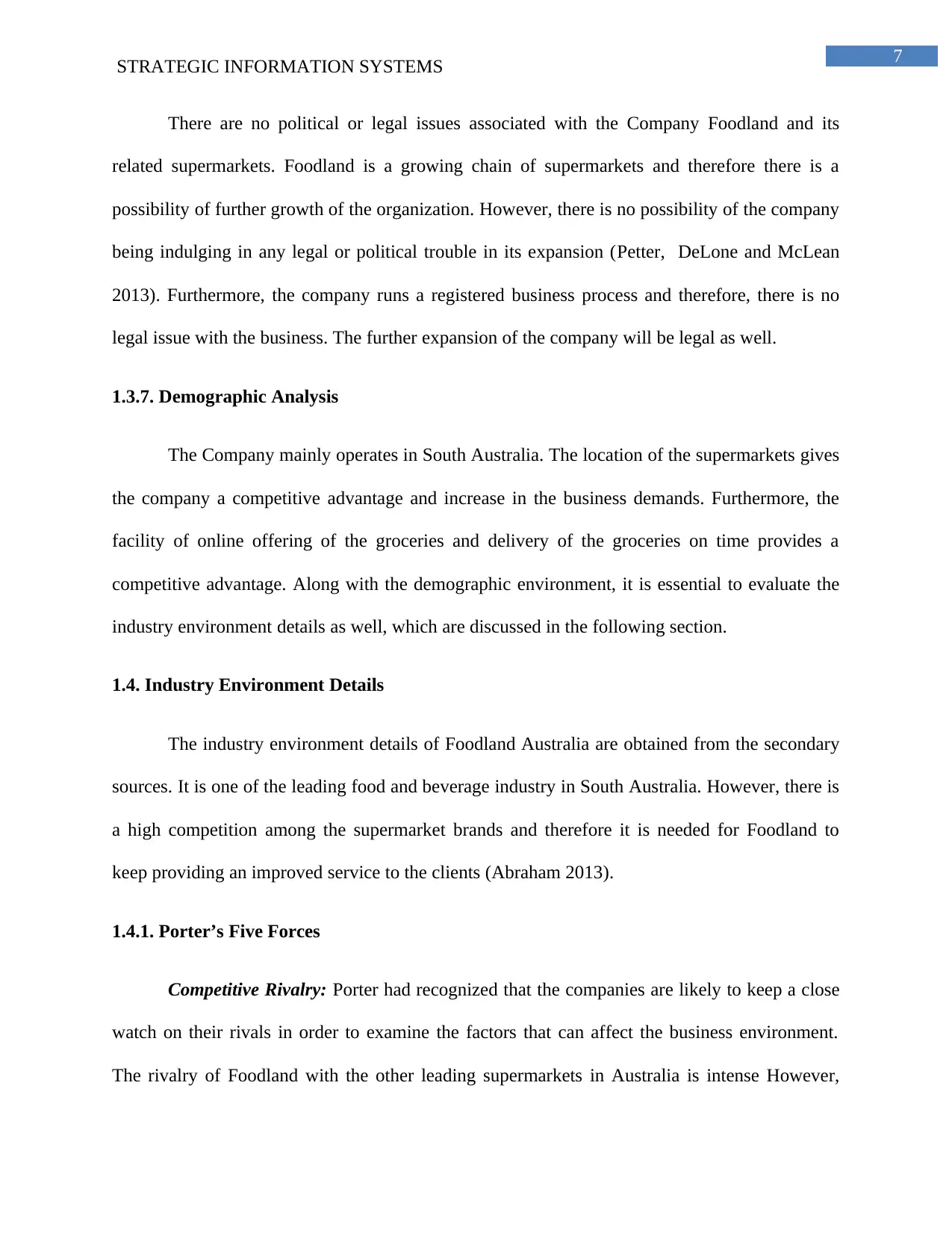
7
STRATEGIC INFORMATION SYSTEMS
There are no political or legal issues associated with the Company Foodland and its
related supermarkets. Foodland is a growing chain of supermarkets and therefore there is a
possibility of further growth of the organization. However, there is no possibility of the company
being indulging in any legal or political trouble in its expansion (Petter, DeLone and McLean
2013). Furthermore, the company runs a registered business process and therefore, there is no
legal issue with the business. The further expansion of the company will be legal as well.
1.3.7. Demographic Analysis
The Company mainly operates in South Australia. The location of the supermarkets gives
the company a competitive advantage and increase in the business demands. Furthermore, the
facility of online offering of the groceries and delivery of the groceries on time provides a
competitive advantage. Along with the demographic environment, it is essential to evaluate the
industry environment details as well, which are discussed in the following section.
1.4. Industry Environment Details
The industry environment details of Foodland Australia are obtained from the secondary
sources. It is one of the leading food and beverage industry in South Australia. However, there is
a high competition among the supermarket brands and therefore it is needed for Foodland to
keep providing an improved service to the clients (Abraham 2013).
1.4.1. Porter’s Five Forces
Competitive Rivalry: Porter had recognized that the companies are likely to keep a close
watch on their rivals in order to examine the factors that can affect the business environment.
The rivalry of Foodland with the other leading supermarkets in Australia is intense However,
STRATEGIC INFORMATION SYSTEMS
There are no political or legal issues associated with the Company Foodland and its
related supermarkets. Foodland is a growing chain of supermarkets and therefore there is a
possibility of further growth of the organization. However, there is no possibility of the company
being indulging in any legal or political trouble in its expansion (Petter, DeLone and McLean
2013). Furthermore, the company runs a registered business process and therefore, there is no
legal issue with the business. The further expansion of the company will be legal as well.
1.3.7. Demographic Analysis
The Company mainly operates in South Australia. The location of the supermarkets gives
the company a competitive advantage and increase in the business demands. Furthermore, the
facility of online offering of the groceries and delivery of the groceries on time provides a
competitive advantage. Along with the demographic environment, it is essential to evaluate the
industry environment details as well, which are discussed in the following section.
1.4. Industry Environment Details
The industry environment details of Foodland Australia are obtained from the secondary
sources. It is one of the leading food and beverage industry in South Australia. However, there is
a high competition among the supermarket brands and therefore it is needed for Foodland to
keep providing an improved service to the clients (Abraham 2013).
1.4.1. Porter’s Five Forces
Competitive Rivalry: Porter had recognized that the companies are likely to keep a close
watch on their rivals in order to examine the factors that can affect the business environment.
The rivalry of Foodland with the other leading supermarkets in Australia is intense However,

8
STRATEGIC INFORMATION SYSTEMS
since Foodland is the only supermarket brand to provide local goods, the effect of the rivalry is
minimum.
Supplier Power: It is necessary to identify the supplier power to recognize the actual
profit margin of the company. Foodland is known for providing local products and developing
customer centric products. The demands of the customer are taken care of (Willcocks 2013).
Thus, Foodland seems to have a great supplier power since the company has a good relation with
the local suppliers.
Buyer Power: The buyers or the customers are an important need for any company.
Customers have the power to strongly affect the profit margin of the company. The Foodland has
a great buyer power as it is the only supermarket in South Australia that provides an access to the
local products.
Threat of Substitution: This is one of the important considerations for a company as it
refers to the likelihood of the customers finding a different way. The threat of substitution is
considerably less for Foodland as it has a good brand power.
Threat of New Entry: A threat can considerably affect the people’s ability to enter the
market in which a particular company is operating Foodland although has the threat of new entry
in form of other supermarkets operating in Australia, it has the ability to suppress the threat by
offering exclusive products.
1.5. Competitive Environment
Foodland has a competition among the other supermarkets in Australia. It has a huge
competition with the other business counterparts such as Woolworths Supermarket, Coles and
STRATEGIC INFORMATION SYSTEMS
since Foodland is the only supermarket brand to provide local goods, the effect of the rivalry is
minimum.
Supplier Power: It is necessary to identify the supplier power to recognize the actual
profit margin of the company. Foodland is known for providing local products and developing
customer centric products. The demands of the customer are taken care of (Willcocks 2013).
Thus, Foodland seems to have a great supplier power since the company has a good relation with
the local suppliers.
Buyer Power: The buyers or the customers are an important need for any company.
Customers have the power to strongly affect the profit margin of the company. The Foodland has
a great buyer power as it is the only supermarket in South Australia that provides an access to the
local products.
Threat of Substitution: This is one of the important considerations for a company as it
refers to the likelihood of the customers finding a different way. The threat of substitution is
considerably less for Foodland as it has a good brand power.
Threat of New Entry: A threat can considerably affect the people’s ability to enter the
market in which a particular company is operating Foodland although has the threat of new entry
in form of other supermarkets operating in Australia, it has the ability to suppress the threat by
offering exclusive products.
1.5. Competitive Environment
Foodland has a competition among the other supermarkets in Australia. It has a huge
competition with the other business counterparts such as Woolworths Supermarket, Coles and
⊘ This is a preview!⊘
Do you want full access?
Subscribe today to unlock all pages.

Trusted by 1+ million students worldwide
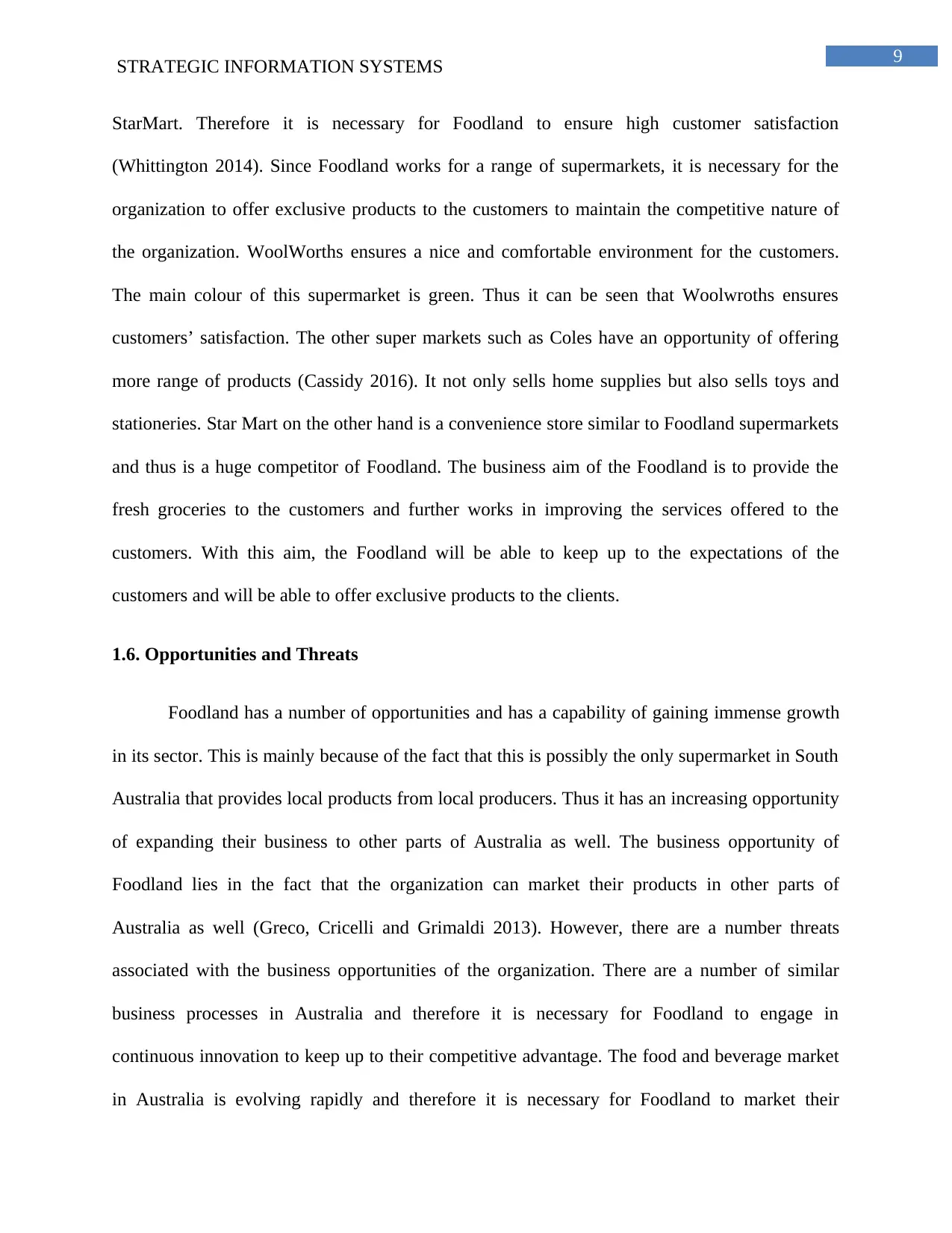
9
STRATEGIC INFORMATION SYSTEMS
StarMart. Therefore it is necessary for Foodland to ensure high customer satisfaction
(Whittington 2014). Since Foodland works for a range of supermarkets, it is necessary for the
organization to offer exclusive products to the customers to maintain the competitive nature of
the organization. WoolWorths ensures a nice and comfortable environment for the customers.
The main colour of this supermarket is green. Thus it can be seen that Woolwroths ensures
customers’ satisfaction. The other super markets such as Coles have an opportunity of offering
more range of products (Cassidy 2016). It not only sells home supplies but also sells toys and
stationeries. Star Mart on the other hand is a convenience store similar to Foodland supermarkets
and thus is a huge competitor of Foodland. The business aim of the Foodland is to provide the
fresh groceries to the customers and further works in improving the services offered to the
customers. With this aim, the Foodland will be able to keep up to the expectations of the
customers and will be able to offer exclusive products to the clients.
1.6. Opportunities and Threats
Foodland has a number of opportunities and has a capability of gaining immense growth
in its sector. This is mainly because of the fact that this is possibly the only supermarket in South
Australia that provides local products from local producers. Thus it has an increasing opportunity
of expanding their business to other parts of Australia as well. The business opportunity of
Foodland lies in the fact that the organization can market their products in other parts of
Australia as well (Greco, Cricelli and Grimaldi 2013). However, there are a number threats
associated with the business opportunities of the organization. There are a number of similar
business processes in Australia and therefore it is necessary for Foodland to engage in
continuous innovation to keep up to their competitive advantage. The food and beverage market
in Australia is evolving rapidly and therefore it is necessary for Foodland to market their
STRATEGIC INFORMATION SYSTEMS
StarMart. Therefore it is necessary for Foodland to ensure high customer satisfaction
(Whittington 2014). Since Foodland works for a range of supermarkets, it is necessary for the
organization to offer exclusive products to the customers to maintain the competitive nature of
the organization. WoolWorths ensures a nice and comfortable environment for the customers.
The main colour of this supermarket is green. Thus it can be seen that Woolwroths ensures
customers’ satisfaction. The other super markets such as Coles have an opportunity of offering
more range of products (Cassidy 2016). It not only sells home supplies but also sells toys and
stationeries. Star Mart on the other hand is a convenience store similar to Foodland supermarkets
and thus is a huge competitor of Foodland. The business aim of the Foodland is to provide the
fresh groceries to the customers and further works in improving the services offered to the
customers. With this aim, the Foodland will be able to keep up to the expectations of the
customers and will be able to offer exclusive products to the clients.
1.6. Opportunities and Threats
Foodland has a number of opportunities and has a capability of gaining immense growth
in its sector. This is mainly because of the fact that this is possibly the only supermarket in South
Australia that provides local products from local producers. Thus it has an increasing opportunity
of expanding their business to other parts of Australia as well. The business opportunity of
Foodland lies in the fact that the organization can market their products in other parts of
Australia as well (Greco, Cricelli and Grimaldi 2013). However, there are a number threats
associated with the business opportunities of the organization. There are a number of similar
business processes in Australia and therefore it is necessary for Foodland to engage in
continuous innovation to keep up to their competitive advantage. The food and beverage market
in Australia is evolving rapidly and therefore it is necessary for Foodland to market their
Paraphrase This Document
Need a fresh take? Get an instant paraphrase of this document with our AI Paraphraser
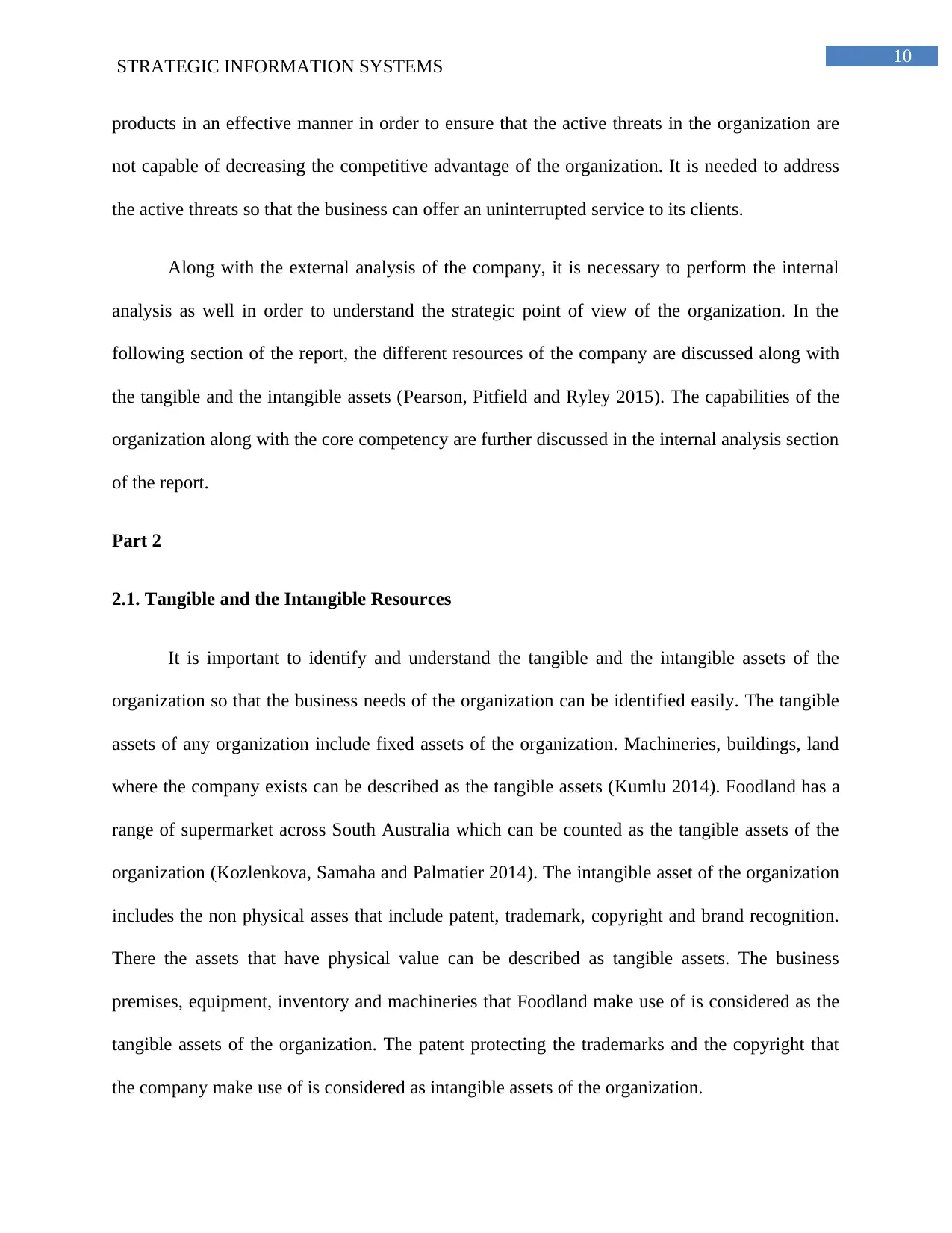
10
STRATEGIC INFORMATION SYSTEMS
products in an effective manner in order to ensure that the active threats in the organization are
not capable of decreasing the competitive advantage of the organization. It is needed to address
the active threats so that the business can offer an uninterrupted service to its clients.
Along with the external analysis of the company, it is necessary to perform the internal
analysis as well in order to understand the strategic point of view of the organization. In the
following section of the report, the different resources of the company are discussed along with
the tangible and the intangible assets (Pearson, Pitfield and Ryley 2015). The capabilities of the
organization along with the core competency are further discussed in the internal analysis section
of the report.
Part 2
2.1. Tangible and the Intangible Resources
It is important to identify and understand the tangible and the intangible assets of the
organization so that the business needs of the organization can be identified easily. The tangible
assets of any organization include fixed assets of the organization. Machineries, buildings, land
where the company exists can be described as the tangible assets (Kumlu 2014). Foodland has a
range of supermarket across South Australia which can be counted as the tangible assets of the
organization (Kozlenkova, Samaha and Palmatier 2014). The intangible asset of the organization
includes the non physical asses that include patent, trademark, copyright and brand recognition.
There the assets that have physical value can be described as tangible assets. The business
premises, equipment, inventory and machineries that Foodland make use of is considered as the
tangible assets of the organization. The patent protecting the trademarks and the copyright that
the company make use of is considered as intangible assets of the organization.
STRATEGIC INFORMATION SYSTEMS
products in an effective manner in order to ensure that the active threats in the organization are
not capable of decreasing the competitive advantage of the organization. It is needed to address
the active threats so that the business can offer an uninterrupted service to its clients.
Along with the external analysis of the company, it is necessary to perform the internal
analysis as well in order to understand the strategic point of view of the organization. In the
following section of the report, the different resources of the company are discussed along with
the tangible and the intangible assets (Pearson, Pitfield and Ryley 2015). The capabilities of the
organization along with the core competency are further discussed in the internal analysis section
of the report.
Part 2
2.1. Tangible and the Intangible Resources
It is important to identify and understand the tangible and the intangible assets of the
organization so that the business needs of the organization can be identified easily. The tangible
assets of any organization include fixed assets of the organization. Machineries, buildings, land
where the company exists can be described as the tangible assets (Kumlu 2014). Foodland has a
range of supermarket across South Australia which can be counted as the tangible assets of the
organization (Kozlenkova, Samaha and Palmatier 2014). The intangible asset of the organization
includes the non physical asses that include patent, trademark, copyright and brand recognition.
There the assets that have physical value can be described as tangible assets. The business
premises, equipment, inventory and machineries that Foodland make use of is considered as the
tangible assets of the organization. The patent protecting the trademarks and the copyright that
the company make use of is considered as intangible assets of the organization.
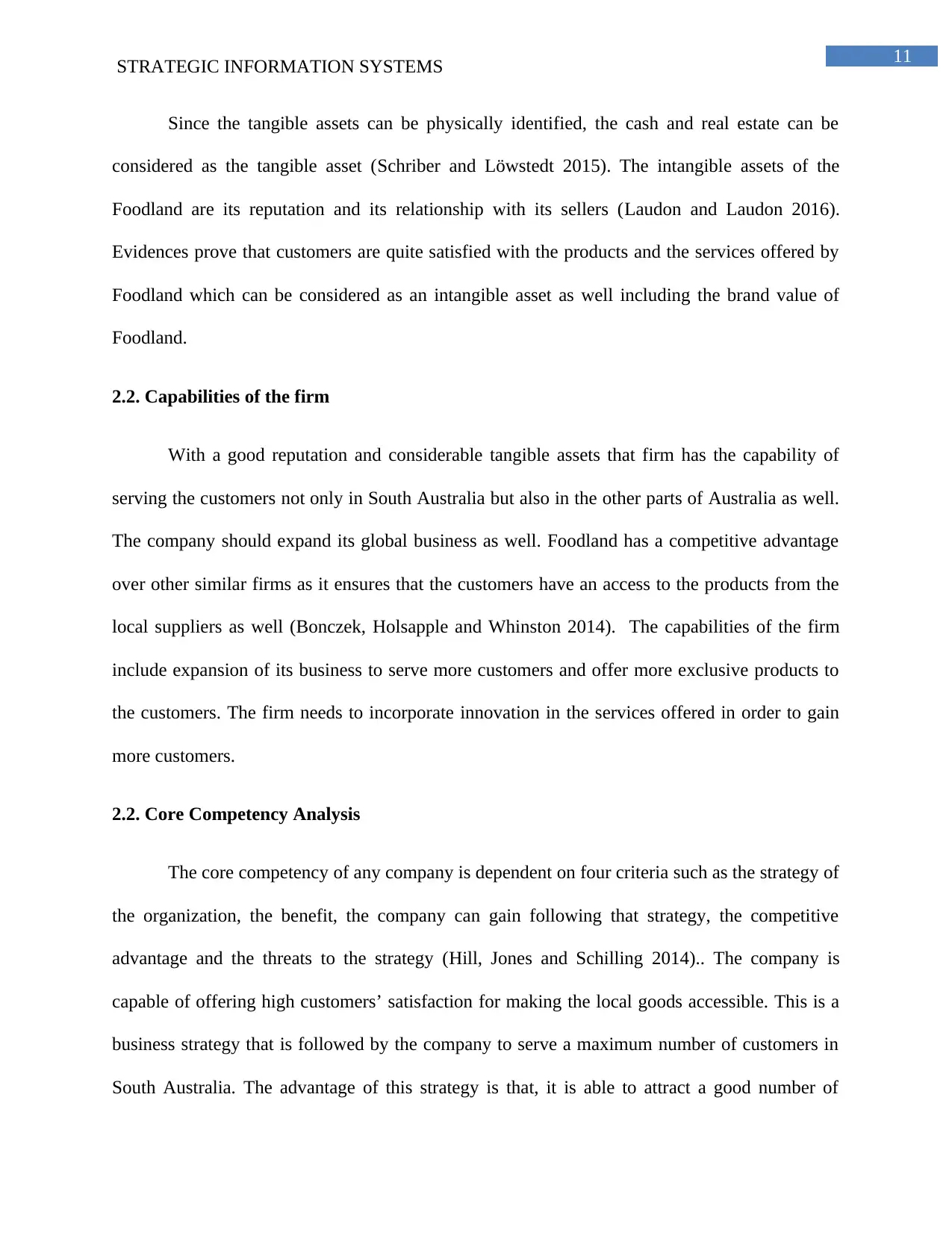
11
STRATEGIC INFORMATION SYSTEMS
Since the tangible assets can be physically identified, the cash and real estate can be
considered as the tangible asset (Schriber and Löwstedt 2015). The intangible assets of the
Foodland are its reputation and its relationship with its sellers (Laudon and Laudon 2016).
Evidences prove that customers are quite satisfied with the products and the services offered by
Foodland which can be considered as an intangible asset as well including the brand value of
Foodland.
2.2. Capabilities of the firm
With a good reputation and considerable tangible assets that firm has the capability of
serving the customers not only in South Australia but also in the other parts of Australia as well.
The company should expand its global business as well. Foodland has a competitive advantage
over other similar firms as it ensures that the customers have an access to the products from the
local suppliers as well (Bonczek, Holsapple and Whinston 2014). The capabilities of the firm
include expansion of its business to serve more customers and offer more exclusive products to
the customers. The firm needs to incorporate innovation in the services offered in order to gain
more customers.
2.2. Core Competency Analysis
The core competency of any company is dependent on four criteria such as the strategy of
the organization, the benefit, the company can gain following that strategy, the competitive
advantage and the threats to the strategy (Hill, Jones and Schilling 2014).. The company is
capable of offering high customers’ satisfaction for making the local goods accessible. This is a
business strategy that is followed by the company to serve a maximum number of customers in
South Australia. The advantage of this strategy is that, it is able to attract a good number of
STRATEGIC INFORMATION SYSTEMS
Since the tangible assets can be physically identified, the cash and real estate can be
considered as the tangible asset (Schriber and Löwstedt 2015). The intangible assets of the
Foodland are its reputation and its relationship with its sellers (Laudon and Laudon 2016).
Evidences prove that customers are quite satisfied with the products and the services offered by
Foodland which can be considered as an intangible asset as well including the brand value of
Foodland.
2.2. Capabilities of the firm
With a good reputation and considerable tangible assets that firm has the capability of
serving the customers not only in South Australia but also in the other parts of Australia as well.
The company should expand its global business as well. Foodland has a competitive advantage
over other similar firms as it ensures that the customers have an access to the products from the
local suppliers as well (Bonczek, Holsapple and Whinston 2014). The capabilities of the firm
include expansion of its business to serve more customers and offer more exclusive products to
the customers. The firm needs to incorporate innovation in the services offered in order to gain
more customers.
2.2. Core Competency Analysis
The core competency of any company is dependent on four criteria such as the strategy of
the organization, the benefit, the company can gain following that strategy, the competitive
advantage and the threats to the strategy (Hill, Jones and Schilling 2014).. The company is
capable of offering high customers’ satisfaction for making the local goods accessible. This is a
business strategy that is followed by the company to serve a maximum number of customers in
South Australia. The advantage of this strategy is that, it is able to attract a good number of
⊘ This is a preview!⊘
Do you want full access?
Subscribe today to unlock all pages.

Trusted by 1+ million students worldwide
1 out of 17
Related Documents
Your All-in-One AI-Powered Toolkit for Academic Success.
+13062052269
info@desklib.com
Available 24*7 on WhatsApp / Email
![[object Object]](/_next/static/media/star-bottom.7253800d.svg)
Unlock your academic potential
Copyright © 2020–2025 A2Z Services. All Rights Reserved. Developed and managed by ZUCOL.




